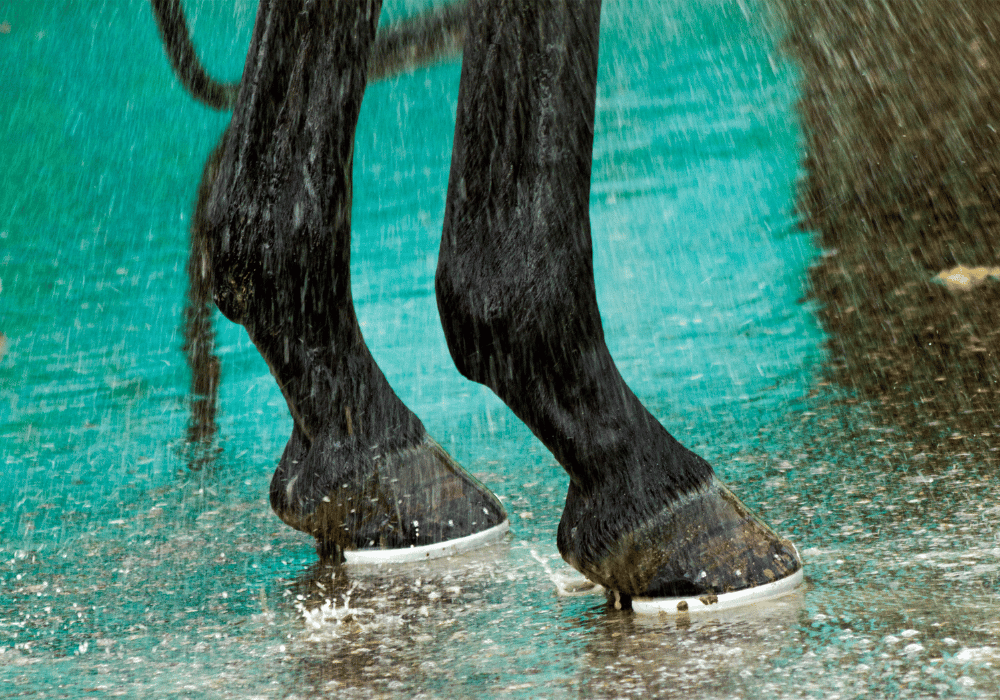The deep digital flexor tendon (DDFT) runs down the back of the horse’s leg, starting with the deep digital flexor muscle, and ends at the pedal bone. Whilst injuries to the DDFT are relatively uncommon, they are serious and require careful treatment and rehabilitation. This guide covers the role of the DDFT, common injuries and treatment options.
Anatomy of the Deep Digital Flexor Tendon
The deep digital flexor tendon can be around 50cm long in an adult horse. It emerges from the deep digital flexor muscle (behind the carpus/knee or hock), down to the pedal bone. The tendons themselves consist of longitudinal bundles of fibres.
The DDFT runs over several joints in the lower leg, where it is encased by the tendon sheaths (bursae). These tendon sheaths contain synovial fluid, which helps the DDFT to run over the joints without friction. The tendon sheaths include the digital sheath, which runs over the fetlock area, the tarsal sheath at the hock and the carpal sheath at the carpus / knee. Short, annular ligaments help to keep the tendons in position in areas of high movement (e.g. the joints).
The DDFT allows the leg to flex and stabilises the lower leg joints whilst they are weight-bearing. As the horse bears its weight on the leg, the DDFT stretches taught, helping to support the joints.
DDFT Injuries
Injury to the deep digital flexor tendon often occurs during exercise. Strenuous exercise can result in tearing of fibres, especially in unfit horses. Fast work, uneven ground and jumping can also lead to overstretching of the tendon, which can result in damage. Poor shoeing or conformation can also increase the risk of an injury to the DDFT.
Injury to the deep digital flexor tendon tends to occur either within the hoof capsule or behind the fetlock and pasterns. Injury to the DDFT in the cannon bone area is much less common. The degree of damage can range from minor damage to total tendon rupture. The treatment for injuries to the deep digital flexor tendon varies depending on the location and severity of the damage. Furthermore, DDFT injuries tend to be serious and can have long-term impacts on the horse’s athletic potential and quality of life.
Tendon Sheath Injuries
DDFT injuries are often found in the areas covered by a tendon sheath. Treating tendon sheath injuries can be particularly difficult due to the structure of the tendon in these areas affecting the healing process. Furthermore, infection of the tendon sheath can be fatal.
Distention of the Digital Flexor Tendon (Windgalls)
DDFT injuries commonly occur in the form of a distention of the digital flexor tendon sheath, otherwise known as a windgall. This type of injury is more common in the hindlimb.
DDFT Injuries Within the Hoof Capsule
Injuries within the hoof capsule are more common within the forelimb. Within the hoof capsule, the DDFT runs behind the navicular bone. The navicular bone and the DDFT are separated by the navicular bursa. Damage in this area can be a major contributing factor to navicular syndrome.
Treating DDFT Injuries
Injuries to the deep digital flexor tendon require careful treatment and an extended period of rest followed by a gradual return to work. Whilst there are several treatment options available, the repaired tendon will always be weaker and more prone to re-injury than a healthy tendon.
Initial treatment usually consists of box rest, regular application of ice or cold hosing, as well as bandaging to immobilise the limb whilst the tendon heals. Pain relief or anti-inflammatory medication (e.g. Bute) may also be administered.
After a period of box rest, controlled exercise can be gradually re-introduced. This will be guided by regular assessments, such as ultrasound scans. Depending on the type and severity of the injury, the horse may or may not be able to return to full work.
Other Therapies and Treatments for Tendon Injuries
There are a range of therapies and treatments available that may be used to treat DDFT injuries. For example, Platelet Rich Plasma (PRP), stem cell treatment or Bone Marrow Aspirate Concentrate (BMAC) are all regenerative treatments that we offer at Avonvale Equine Vet Practice. Extra-corporeal Shockwave Therapy can also be used to treat some tendon injuries.
Avonvale Equine Vet Practice
We are an independent equine vet practice covering Oxfordshire, Warwickshire, the West Midlands and the Cotswolds. From our clinic in Ratley, we can offer a range of diagnostic tests, therapies and treatments for tendon injuries. Our vets have a wealth of expertise in equine orthopaedic medicine and can advise you on the suitability of these treatments for your horse. Register your horse, pony, donkey or mule with us today.








